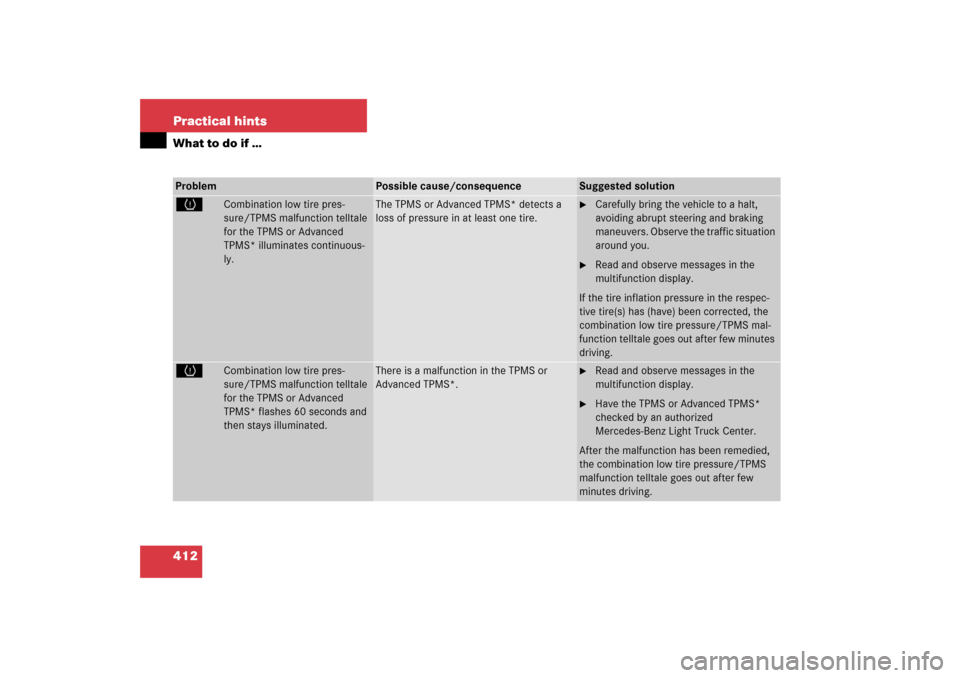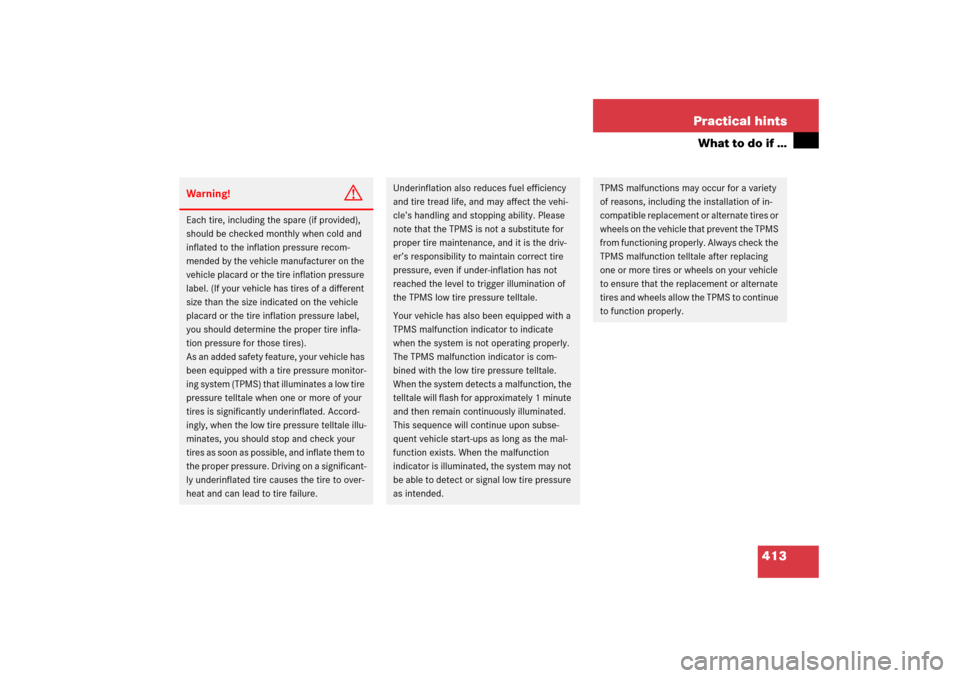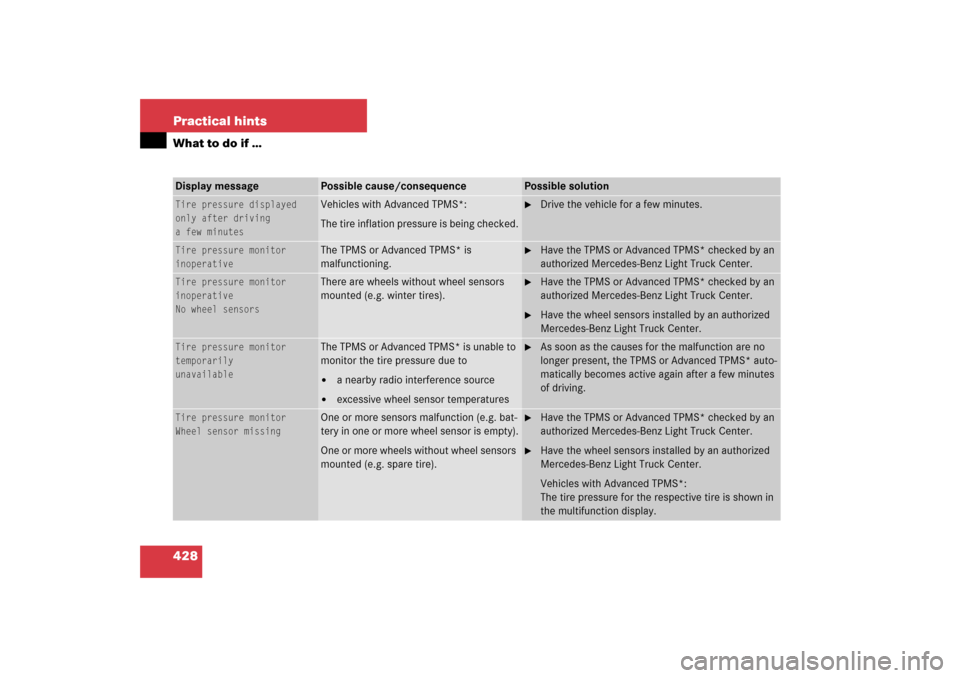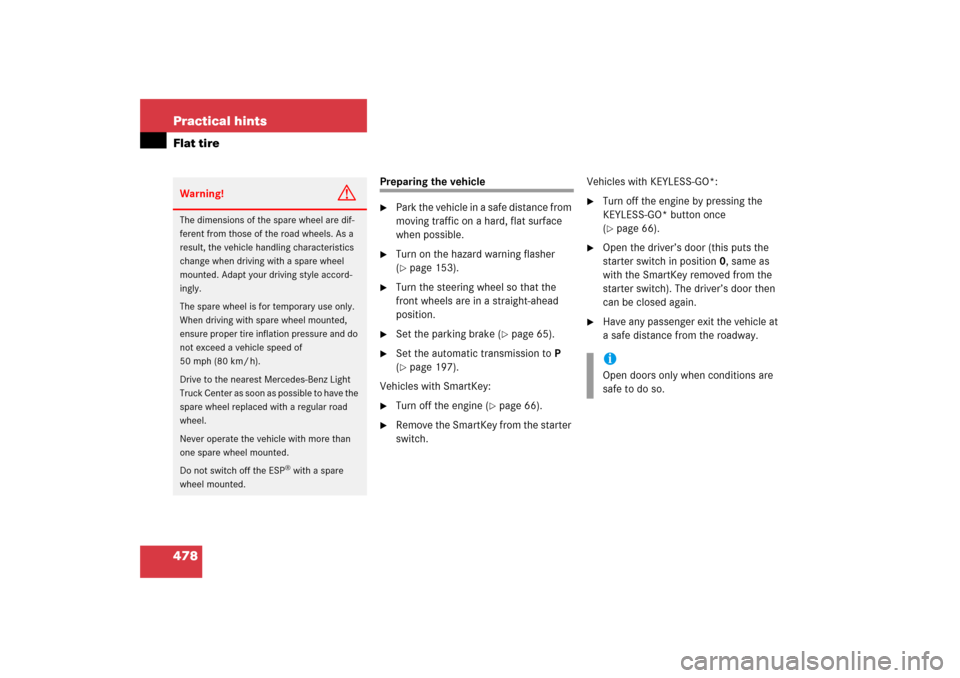Page 390 of 561

389 Operation
Tires and wheels
In some cases, such as when your vehicle
is equipped with mixed-size tires (different
tire dimension front vs. rear), tire rotation
is not possible.
If applicable to your vehicle's tire configu-
ration, tires can be rotated according to
the tire manufacturer’s recommended in-
tervals in the tire manufacturer’s warranty
pamphlet located in your vehicle literature
portfolio. If none is available, tires should
be rotated every 3 000 to 6 000 miles
(5 000 to 10 000 km), or sooner if neces-
sary, according to the degree of tire wear.
The same rotation (spinning) direction
must be maintained (
�page 356).
Rotate tires before the characteristic tire
wear pattern becomes visible (shoulder
wear on front tires and tread center wear
on rear tires).
Thoroughly clean the mounting face of
wheels and brake disks, i.e. the inner side
of the wheels/tires, during each rotation.
Check for and ensure proper tire inflation
pressure.For information on wheel change, see “Flat
tire” (
�page 478).
Warning!
G
Have the tightening torque checked after
changing a wheel. Wheels could become
loose if not tightened with a torque of
110 lb-ft (150 Nm).
Only use genuine Mercedes-Benz wheel
bolts specified for your vehicle’s rims.
Page 413 of 561

412 Practical hintsWhat to do if …Problem
Possible cause/consequence
Suggested solution
H
Combination low tire pres-
sure/TPMS malfunction telltale
for the TPMS or Advanced
TPMS* illuminates continuous-
ly.
The TPMS or Advanced TPMS* detects a
loss of pressure in at least one tire.
�
Carefully bring the vehicle to a halt,
avoiding abrupt steering and braking
maneuvers. Observe the traffic situation
around you.
�
Read and observe messages in the
multifunction display.
If the tire inflation pressure in the respec-
tive tire(s) has (have) been corrected, the
combination low tire pressure/TPMS mal-
function telltale goes out after few minutes
driving.
H
Combination low tire pres-
sure/TPMS malfunction telltale
for the TPMS or Advanced
TPMS* flashes 60 seconds and
then stays illuminated.
There is a malfunction in the TPMS or
Advanced TPMS*.
�
Read and observe messages in the
multifunction display.
�
Have the TPMS or Advanced TPMS*
checked by an authorized
Mercedes-Benz Light Truck Center.
After the malfunction has been remedied,
the combination low tire pressure/TPMS
malfunction telltale goes out after few
minutes driving.
Page 414 of 561

413 Practical hints
What to do if …
Warning!
G
Each tire, including the spare (if provided),
should be checked monthly when cold and
inflated to the inflation pressure recom-
mended by the vehicle manufacturer on the
vehicle placard or the tire inflation pressure
label. (If your vehicle has tires of a different
size than the size indicated on the vehicle
placard or the tire inflation pressure label,
you should determine the proper tire infla-
tion pressure for those tires).
As an added safety feature, your vehicle has
been equipped with a tire pressure monitor-
ing system (TPMS) that illuminates a low tire
pressure telltale when one or more of your
tires is significantly underinflated. Accord-
ingly, when the low tire pressure telltale illu-
minates, you should stop and check your
tires as soon as possible, and inflate them to
the proper pressure. Driving on a significant-
ly underinflated tire causes the tire to over-
heat and can lead to tire failure.
Underinflation also reduces fuel efficiency
and tire tread life, and may affect the vehi-
cle’s handling and stopping ability. Please
note that the TPMS is not a substitute for
proper tire maintenance, and it is the driv-
er’s responsibility to maintain correct tire
pressure, even if under-inflation has not
reached the level to trigger illumination of
the TPMS low tire pressure telltale.
Your vehicle has also been equipped with a
TPMS malfunction indicator to indicate
when the system is not operating properly.
The TPMS malfunction indicator is com-
bined with the low tire pressure telltale.
When the system detects a malfunction, the
telltale will flash for approximately 1 minute
and then remain continuously illuminated.
This sequence will continue upon subse-
quent vehicle start-ups as long as the mal-
function exists. When the malfunction
indicator is illuminated, the system may not
be able to detect or signal low tire pressure
as intended.
TPMS malfunctions may occur for a variety
of reasons, including the installation of in-
compatible replacement or alternate tires or
wheels on the vehicle that prevent the TPMS
from functioning properly. Always check the
TPMS malfunction telltale after replacing
one or more tires or wheels on your vehicle
to ensure that the replacement or alternate
tires and wheels allow the TPMS to continue
to function properly.
Page 428 of 561

427 Practical hints
What to do if …
Display message
Possible cause/consequence
Possible solution
Check tires
Then reactivate
Run Flat Indicator
There was a warning message about
a loss in the tire inflation pressure
and the Run Flat Indicator has not
been reactivated yet.
�
Make sure that the correct tire inflation pressure is set
for each tire.
�
Then reactivate the Run Flat Indicator.
Run Flat Indicator
inactive
Run Flat Indicator is malfunctioning.
�
Have the Run Flat Indicator checked by an authorized
Mercedes-Benz Light Truck Center.
Run Flat Indicator
unavailable
The Run Flat Indicator has been
switched off due to an error.
�
Have the Run Flat Indicator checked by an authorized
Mercedes-Benz Light Truck Center.
Tire pressure
Check tires
The Run Flat Indicator indicates that
the pressure is too low in one or more
tires.
�
Carefully bring the vehicle to a halt, avoiding abrupt
steering and braking maneuvers. Observe the traffic sit-
uation around you.
�
Check and adjust tire inflation pressure as required
(�page 365).
�
If necessary, change the wheel (
�page 478).
�
Reactivate the Run Flat Indicator after adjusting the tire
inflation pressure values (
�page 365).
Page 429 of 561

428 Practical hintsWhat to do if …Display message
Possible cause/consequence
Possible solution
Tire pressure displayed
only after driving
a few minutes
Vehicles with Advanced TPMS*:
The tire inflation pressure is being checked.
�
Drive the vehicle for a few minutes.
Tire pressure monitor
inoperative
The TPMS or Advanced TPMS* is
malfunctioning.
�
Have the TPMS or Advanced TPMS* checked by an
authorized Mercedes-Benz Light Truck Center.
Tire pressure monitor
inoperative
No wheel sensors
There are wheels without wheel sensors
mounted (e.g. winter tires).
�
Have the TPMS or Advanced TPMS* checked by an
authorized Mercedes-Benz Light Truck Center.
�
Have the wheel sensors installed by an authorized
Mercedes-Benz Light Truck Center.
Tire pressure monitor
temporarily
unavailable
The TPMS or Advanced TPMS* is unable to
monitor the tire pressure due to�
a nearby radio interference source
�
excessive wheel sensor temperatures
�
As soon as the causes for the malfunction are no
longer present, the TPMS or Advanced TPMS* auto-
matically becomes active again after a few minutes
of driving.
Tire pressure monitor
Wheel sensor missing
One or more sensors malfunction (e.g. bat-
tery in one or more wheel sensor is empty).
One or more wheels without wheel sensors
mounted (e.g. spare tire).
�
Have the TPMS or Advanced TPMS* checked by an
authorized Mercedes-Benz Light Truck Center.
�
Have the wheel sensors installed by an authorized
Mercedes-Benz Light Truck Center.
Vehicles with Advanced TPMS*:
The tire pressure for the respective tire is shown in
the multifunction display.
Page 449 of 561
448 Practical hintsWhat to do if …Display symbol
Display messages
Possible cause/consequence
Possible solution
H
Rectify
tire pressure
The pressure is too low in one or more
tires.
�
Check and correct tire inflation
pressure as required.
Tire pressure
Caution: Tire defect
One or more tires are deflating.
�
Carefully bring the vehicle to a halt,
avoiding abrupt steering and braking
maneuvers.
�
If necessary, change the wheel.
Caution: Tire defect
Vehicles with Advanced TPMS*:
One or more tires are deflating.
The respective tire is shown in the
multifunction display.
�
Carefully bring the vehicle to a halt,
avoiding abrupt steering and braking
maneuvers.
�
If necessary, change the wheel.
Warning!
G
Do not drive with a flat tire. A flat tire affects
the ability to steer or brake the vehicle. You
may lose control of the vehicle. Continued
driving with a flat tire will cause excessive
heat build-up and possibly a fire.
Page 450 of 561
449 Practical hints
What to do if …
Display symbol
Display messages
Possible cause/consequence
Possible solution
H
Tire pressure
Check tires
The tire pressure in one or more tires is
already below the minimum value.
�
Carefully bring the vehicle to a halt,
avoiding abrupt steering and braking
maneuvers.
�
Check and adjust tire inflation
pressure as required.
�
If necessary, change the wheel.
Check tires
Vehicles with Advanced TPMS*:
The tire pressure in one or more tires is
already below the minimum value.
The respective tire is shown in the
multifunction display.
�
Carefully bring the vehicle to a halt,
avoiding abrupt steering and braking
maneuvers.
�
Check and adjust tire inflation
pressure as required.
�
If necessary, change the wheel.
Warning!
G
Do not drive with a flat tire. A flat tire affects
the ability to steer or brake the vehicle. You
may lose control of the vehicle. Continued
driving with a flat tire will cause excessive
heat build-up and possibly a fire.
Page 479 of 561

478 Practical hintsFlat tire
Preparing the vehicle�
Park the vehicle in a safe distance from
moving traffic on a hard, flat surface
when possible.
�
Turn on the hazard warning flasher
(�page 153).
�
Turn the steering wheel so that the
front wheels are in a straight-ahead
position.
�
Set the parking brake (
�page 65).
�
Set the automatic transmission to P
(�page 197).
Vehicles with SmartKey:
�
Turn off the engine (
�page 66).
�
Remove the SmartKey from the starter
switch.Vehicles with KEYLESS-GO*:
�
Turn off the engine by pressing the
KEYLESS-GO* button once
(�page 66).
�
Open the driver’s door (this puts the
starter switch in position 0, same as
with the SmartKey removed from the
starter switch). The driver’s door then
can be closed again.
�
Have any passenger exit the vehicle at
a safe distance from the roadway.
Warning!
G
The dimensions of the spare wheel are dif-
ferent from those of the road wheels. As a
result, the vehicle handling characteristics
change when driving with a spare wheel
mounted. Adapt your driving style accord-
ingly.
The spare wheel is for temporary use only.
When driving with spare wheel mounted,
ensure proper tire inflation pressure and do
not exceed a vehicle speed of
50 mph (80 km/ h).
Drive to the nearest Mercedes-Benz Light
Truck Center as soon as possible to have the
spare wheel replaced with a regular road
wheel.
Never operate the vehicle with more than
one spare wheel mounted.
Do not switch off the ESP
® with a spare
wheel mounted.
iOpen doors only when conditions are
safe to do so.